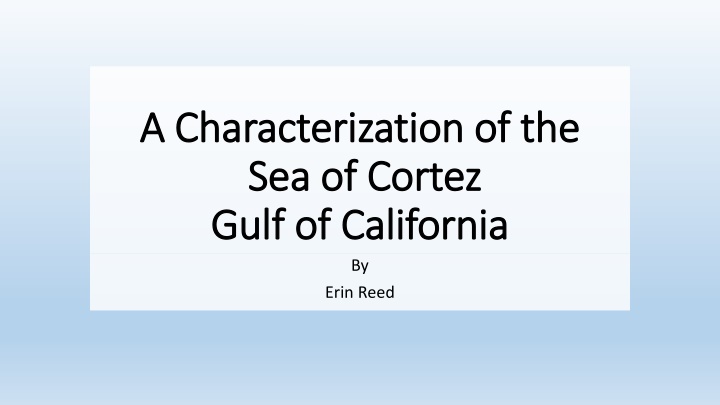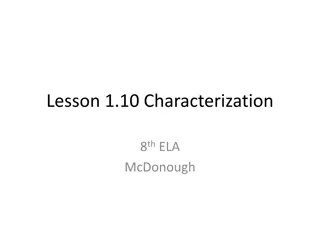Characterization of the Sea of Cortez: Overview and Analysis by Erin Reed
The Sea of Cortez, also known as the Gulf of California, is a unique marine ecosystem located between mainland Mexico and Baja California. This article presents an in-depth exploration of the sea's importance as habitat and nursery grounds for marine life, focusing on the challenges and opportunities it presents for both fish populations and human activities. The use of GIS technology for data characterization and analysis is discussed, shedding light on the ongoing efforts to study and understand this ecologically significant region.
Download Presentation

Please find below an Image/Link to download the presentation.
The content on the website is provided AS IS for your information and personal use only. It may not be sold, licensed, or shared on other websites without obtaining consent from the author.If you encounter any issues during the download, it is possible that the publisher has removed the file from their server.
You are allowed to download the files provided on this website for personal or commercial use, subject to the condition that they are used lawfully. All files are the property of their respective owners.
The content on the website is provided AS IS for your information and personal use only. It may not be sold, licensed, or shared on other websites without obtaining consent from the author.
E N D
Presentation Transcript
A Characterization of the A Characterization of the Sea of Cortez Sea of Cortez Gulf of California Gulf of California By Erin Reed
Outline for today Outline for today Background Work done to date Problems encountered Future work
Background: Background: Between mainland Mexico and Baja California 150 Km wide and 1,100 Km long Depths 200 m (N. Gulf) to 3,600 m at (S. Gulf) Upper GOC (N.Gulf) inverse estuary yearly temp range 32C- 8C Figure 1 Lavin and Marinone 1998
Important Habitat and Nursery Grounds Important Habitat and Nursery Grounds Not cool man!! Small scale fisheries are of high economic value in GOC Aggregate spawners, problem for fish, ideal for human Gulf Corvina spawns with lunar cycles, primarily April
GIS Characterization GIS Characterization NOAA Climate Data ESRL PSD Variables SST U-wind V-wind Data Range 1960-2013 This project April, 1974 only
GIS Characterization: Conversion GIS Characterization: Conversion Identify obtain general idea of the content Conversion Tool Converted from Raster to point Manipulate data easier
GIS Characterization: Sampling Stations GIS Characterization: Sampling Stations Sampling Stations 1-154 U- wind and V-wind SST 1-155 Tool: Extract values to points Now can compare values Inside of Sea of Cortez Pacific Side Baja Peninsula
GIS Characterization: Beginnings of analysis GIS Characterization: Beginnings of analysis
GIS Characterization: Beginnings of Analysis GIS Characterization: Beginnings of Analysis SST (C) 22.5 Station ID Distance (km) SST ( C) V-wind (N/S) U-wind (E/W) 22 20 142.96 19.52 4.37 1.86 21.5 TEMPERATURE (C) 31 313.21 18.87 2.5 1.38 21 50 590.41 20.36 -3.51 2.19 20.5 63 757.92 20.45 -1.87 1.46 20 76 924.62 22.2 -0.66 -2.07 19.5 89 1090.55 21.9 -1.11 1.22 19 104 1255.75 21.03 -1.31 1.07 18.5 0.00 200.00 400.00 600.00 DISTANCE (KM) 800.00 1000.00 1200.00 1400.00
Problems Encountered Problems Encountered Obtaining Data Selecting appropriate data Month/year Formatting three variables together Fixing data inconsistencies (gaps) Different numbers of sampling sites
Future Work Future Work GIS: 3 sections, North, Central, South Contrast Pacific vs. Sea of Cortez Hot spot tool Environmental tracers for migrations Salinity, SST
Thank you!! Thank you!! Gonzalo Espinoza Dr. Maidment Dr. Erisman























